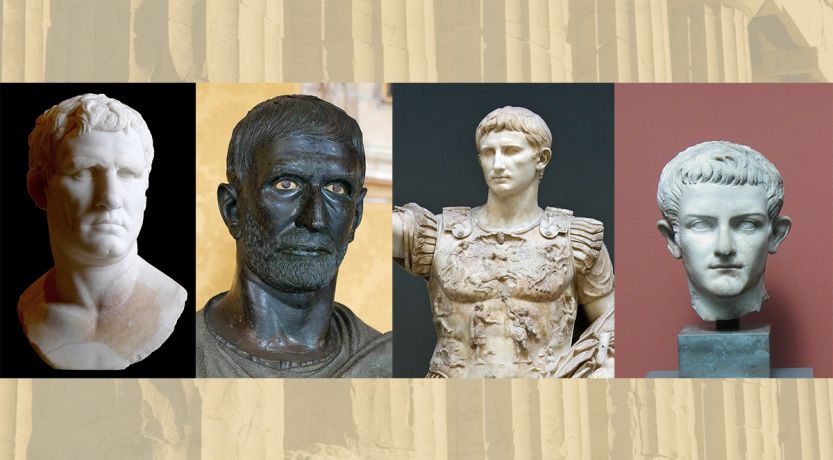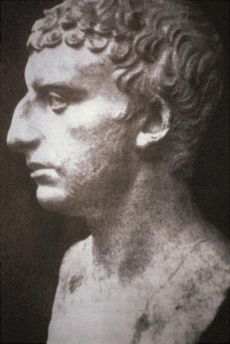What image comes to mind when you think of Jesus? Many imagine Jesus as artists have drawn Him, but is such an image supported or contradicted by the Bible?

Sculpted busts show it was common for first-century Roman men to wear short hair. Paul even said it was a shame for a man to have long hair.
Few people spent more time with Jesus Christ than the 12 disciples. Of those 12, three men formed His closest inner circle—Peter, James and John. They spent thousands of hours with Him—walking from town to town, socializing, eating meals and listening to Him teach.
Now imagine if those three men were raised from the dead today and shown traditional artistic images of Jesus (statues from Catholic churches, portraits from Protestant churches and maybe one or two movies about Christ’s life).
Would they recognize the pale, long-haired man wearing a white robe portrayed in so many of those images? Or would they look puzzlingly, wondering who that man was supposed to be?
In all likelihood, their reaction would be the latter! They would have no idea who was in the images and would likely tell you that nobody in their community looked anything like that.
Does the popular image of Jesus as a thin, long-haired, pale-complexioned man accurately reflect the real Jesus of Nazareth? Or did the popular image of Jesus originate from sources totally outside of the Bible? Does the Bible give us any clues about Jesus’ physical appearance?
Filling in the blanks where the Bible is silent
The Bible has much to say on a lot of things! Yet there are also things that the Bible is noticeably vague or silent about. When we come to those areas, we should stop to think: Perhaps there’s a reason God inspired the Bible to be ambiguous or silent on some topics. Sadly, many of the biggest myths about Jesus are a result of people “filling in the blanks” of the Bible with human ideas.
For example, consider the birth of Jesus. Though the Bible reveals some information, many key details were purposefully not revealed—a main one being the specific month and date of Christ’s birth. Instead of taking this silence as a hint that God didn’t intend us to know and celebrate Jesus’ birth, religious leaders filled in that blank with Dec. 25. They borrowed it from the birthdays of ancient pagan gods that were celebrated on this day because of the winter solstice. To learn more about these myths, read “The Birth of Jesus.”
This is also what has happened with Christ’s appearance. The Bible tells us almost nothing specific about Jesus’ physical characteristics. The emphasis of the Gospel accounts is on what He said and what He did. Again, this should force us to consider—is there a reason these details are left blank?
How does the Bible describe Jesus’ appearance?
Though the Holy Scriptures came with no illustration or written description of Jesus the Man, there is one major clue the Bible gives us about Jesus’ appearance:
Jesus looked like an average Jewish man of His time.
Yes, that’s basically it.
Isaiah 53 is a messianic prophecy about Christ’s suffering and sacrifice. It begins with a prophecy about His appearance: “He has no form or comeliness [or splendor]; and when we see Him, there is no beauty that we should desire Him” (verse 2). In other words, people wouldn’t be drawn to Jesus because He was strikingly handsome, unusually tall or had a distinctive appearance.
We are told that He was to come from the tribe of Judah (Genesis 49:10; Micah 5:2; Matthew 1:1-16)—which made Him a Jewish man.
The Gospel accounts confirm the Isaiah 53 prophecy. Luke 4 gives an account of Jesus speaking in a Nazareth synagogue early in His ministry. After Jesus openly told those present that He was fulfilling messianic prophecies (verses 17-21), a mob formed to try to kill Him right there! Luke added an interesting detail in His Gospel about how Jesus escaped: “Then passing through the midst of them, He went His way” (Luke 4:30).
Jesus could easily slip out of this mob because He looked just like everyone else there. Jesus’ average-looking appearance helped Him escape many dangerous situations throughout His ministry (John 8:59; 10:39). In John 7 we read about Jesus’ last Feast of Tabernacles and His decision to travel to Jerusalem secretly because His life was in danger (verse 10). Jesus was able to go incognito for the first part of the Feast by just blending into the crowd—only becoming publicly known when He stood up to teach (verse 14).
In fact, throughout the Gospel accounts, the only times we see Jesus drawing attention is when He was speaking or performing miracles. In casual situations, He simply looked like everyone else. This is part of the reason Judas, when He betrayed Jesus to the Jewish authorities, had to use a sign to identify the correct man to arrest (Matthew 26:48; Mark 14:44). He looked just like everyone else!
What did a first-century Jewish man look like?
In 2002 Popular Mechanics reported on a group of forensic anthropologists who teamed up with Israeli archaeologists to investigate what an ordinary first-century Jewish man would have looked like. The team researched first-century Semitic skulls from the Galilean region and drawings of people found in Israeli archaeological sites. The image of the common first-century Jew they devised shares almost no characteristics with the traditional image of Jesus portrayed in religious art.
Their research found the following common characteristics of first-century Jews:
- Dark eyes.
- Bearded (Isaiah 50:6 indicates the Messiah would wear a beard).
- Around 5 foot, 1 inch tall.
- Average weight of 110 pounds.
Two other characteristics the researchers used to try to reconstruct “The Real Face of Jesus” were based on additional biblical clues.
Contradicting how Jesus is often portrayed, they concluded that Jesus would have had short, dark hair with “tight curls.” Paintings and busts of men from the first century show that men commonly wore short hair.
This bust of first-century Jewish historian Flavius Josephus shows that men of the time commonly wore short hair.
This is consistent with the biblical evidence. The strongest evidence in the Bible comes from Paul’s first epistle to the Corinthians. Right after telling the Corinthians to “imitate me, just as I also imitate Christ” (1 Corinthians 11:1), Paul wrote about the issue of head coverings and hair lengths. Paul said, “Does not even nature itself teach you that if a man has long hair, it is a dishonor to him?” (verse 14).
The Greek word translated “dishonor” is atimia, a very strong word meaning “dishonor, ignominy, disgrace” (Thayer’s Greek Lexicon). The sense of Paul’s statement is that the natural order teaches that men and women should be distinguished by their hair lengths—men with shorter hair and women with longer hair.
History gives context to Paul’s statement about “nature”: “Similar moral judgments against wearing long hair can be found in Epictetus, Philo, Euphrates, and Plutarch. For the male it was not an acceptable mode of grooming” (Thomas Mathews, The Clash of Gods, 1993, p. 126). Roman men, as can be easily seen in sculpted busts from the time, commonly wore short hair. In fact, the male gods of the Roman pantheon were often portrayed with long hair—to distinguish them from mortal men.
If Jesus wore long hair, would it make sense for the apostle Paul to so strongly criticize long hair on men? Is it correct for us to portray or think of Him in a way that would dishonor Him, according to Paul’s words? It is obvious that the historical Jesus wore short hair, in line with the standards of the time and the teachings of God’s Word.
The scientists also concluded that “since Jesus worked outdoors as a carpenter until he was about 30 years old, it is reasonable to assume he was more muscular and physically fit than westernized portraits suggest. His face was probably weather-beaten, which would have made him appear older, as well.”
Jesus was not the slender, pale and slightly effeminate image we see in art or the movies. Jesus would have been a strong, short-haired, tanned Jewish male.
But other than those broad generalities, we don’t know any other specifics about His appearance, because God chose not to preserve those details in His Word.
Discover the real Jesus
In 2 Corinthians 11:4 Paul warned about the preaching of “another Jesus.” Sadly, that other Jesus did arise and subverted the true Jesus of the Bible. This other Jesus not only teaches doctrines that contradict the true Jesus, but also has an appearance that contradicts the likely appearance of the historical Jesus.
Though we have clues about Jesus’ appearance, the Bible is intentionally vague for a reason. Images portraying God are forbidden in God’s law (Exodus 20:4-6). History documents that, in accordance with the Second Commandment, early Christians did not draw pictures of Jesus. Images portraying Jesus did not become popular until the fifth century—about 300 years after the close of the New Testament era.
Because of the lack of details in the Gospel accounts, “painters, sculptors, and mosaic workers invented without inhibition. The narratives of the Gospel they rewrote with freedom to forge images of memorable impact” (Mathews, p. 180).
Instead of allowing the ideas of man to determine our image of Jesus, God wants us to understand Jesus through His Word by focusing on what Jesus did and taught—not how He looked.
Did Jesus Take a Nazirite Vow?
The Old Testament describes a special vow called the Nazirite vow. Those who took that vow had to do things that separated them from the Israelite community (Numbers 6:1-21). For instance, those under the vow couldn’t drink wine or eat anything derived from grapes (verses 3-4). They also could not touch a dead body (verse 6) or cut their hair throughout the duration of the vow (verse 5). But when the vow was over, they had to cut the long hair off (verse 18). Samson, the judge, was the most famous biblical character who was under this vow (Judges 16:17).
Some have mistakenly believed that Jesus was under this vow, confusing the term Nazirite with Nazarene. Jesus was a Nazarene because He was from the town of Nazareth (Matthew 2:23). But there is no evidence He ever took a Nazirite vow. In fact, we know He wasn’t under a Nazirite vow during His ministry because He drank wine and could touch a dead body (Luke 7:33-34; Mark 5:41).
The Nazirite vow does teach us that it was uncommon for Israelite men to wear long hair. Since the Nazirite vow was all about living in a way that separated those taking the vow from the community, the fact that it included growing long hair shows us that the common man wore short hair.





